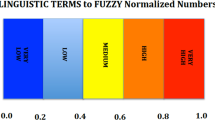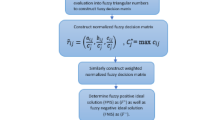Abstract
An optimum selection of potential future energy resources is now need of all the nations. This study aim1s to rank viable energy resources for India. We consider six sources of energy namely, hydropower, solar, wind, coal and lignite, gas and liquid, and nuclear energy. The objective is to provide a quantitative analysis for the selection of most feasible and sustainable source of energy by critically analyzing them based on six criteria namely: feasibility, investment ratio, useful life, operational and management cost, risk in operation and pollutants emission. We have employed fuzzy and interval-based multiple attribute decision making approaches in order to consider uncertainty associated with the data. The criteria understudy are prioritized using modified digital logic method. Our results show that wind and solar energy are the most effective sources of energy due to their ease of access, lack of risk and eco-friendly nature.




Similar content being viewed by others
References
Saaty, T.: How to make a decision: the analytic hierarchy process. Eur. J. Oper. Res. 48, 9–26 (1990)
Opricovic, S., Tzeng, G.H.: Extended VIKOR method in comparison with outranking methods. Eur. J. Oper. Res. 178, 514–529 (2007)
Deng, H., Yeh, C.H., Willis, R.J.: Inter-company comparison using TOPSIS with objective weights. Comput. Oper. Res. 27, 963–973 (2000)
Roy, B., Vincke, P.: Multi-criteria analysis: survey and new directions. Eur. J. Oper. Res. 158, 378–389 (1981)
Pratyyush, S., Jian-Bo, Y.: Multiple Criteria Decision Support in Engineering Design. Springer, Berlin (1998)
Chauhan, A., Vaish, R.: Magnetic material selection using multiple attribute decision making approach. Mater. Des. 36, 1–5 (2012)
Chauhan, A., Vaish, R.: A comparative study on material selection for micro-electromechanical systems. Mater. Des. 41, 177–181 (2012)
Chauhan, A., Vaish, R.: Hard coating material selection using multi-criteria decision making. Mater. Des. 44, 40–45 (2013)
Topcu, Y.I., Ulengin, F.: Energy for the future: an integrated decision aid for the case of Turkey. Energy 29, 137–154 (2004)
San Cristóbal, J.R.: Multi-criteria decision-making in the selection of a renewable energy project in Spain: the Vikor method. Renew. Energy 36, 498–502 (2011)
Wanga, B., Kocaoglu, D.F., Daim, T.U., Yang, J.: A decision model for energy resource selection in China. Energy Policy 38, 7130–7141 (2010)
Meng, Z., Jingsong, Y., Rongrong, R.: The method of interval multi-attribute decision-making based on cross entropy. In: 2012 IEEE 3rd International Conference on Software Engineering and Service Science (ICSESS), pp. 461–464 (2012)
Sayadi, M.K., Heydari, M., Shahanaghi, K.: Extension of VIKOR method for decision making problem with interval numbers. Appl. Math. Model. 33, 2257–2262 (2009)
Chauhan, A., Vaish, R.: A comparative study on decision making methods with interval data. J. Comput. Eng. 2014, Article ID 793074 (2014). doi:10.1155/2014/793074
Girubha, R.J., Vinodh, S.: Application of fuzzy VIKOR and environmental impact analysis for material selection of an automotive component. Mater. Des. 37, 478–486 (2012)
Shemshadi, A., Shirazi, H., Toreihi, M., Tarokh, M.J.: A fuzzy VIKOR method for supplier selection based on entropy measure for objective weighting. Expert Syst. Appl. 38, 12160–7 (2011)
Opricovic, S.: Fuzzy VIKOR with an application to water resources planning. Expert Syst. Appl. 38, 12983–90 (2011)
Report-Energy Statistics 2012, Central Statistics Office. National Statistical Organisation. Ministry of Statistics and Programme Implementation, Government of India
Chandrasekharam, D.: Geothermal energy resources of India: past and the present. In: World Geothermal Congress 2005, Antalya, Turkey, 24–29 April 2005 (2005)
Kumar, A.A., Karthick, K.: Clean energy resources available in India. Int. J. Environ. Sci. Dev. 2(1), 1–7 (2011)
Dreaming with BRICs: the path to 2050. Global Economics Paper No. 99, Goldman Sachs, 1st October 2003
Chang, S.L., Wang, R.C., Wang, S.Y.: Applying fuzzy linguistic quantifier to select supply chain partners at different phases of product life cycle. Int. J. Prod. Econ. 100, 348–359 (2006)
Boran, F.E., Boran, K., Menlik, T.: The evaluation of renewable energy technologies for electricity generation in Turkey using intuitionistic fuzzy TOPSIS. Energy Sources Part B: Econ. Plan. Policy 7, 81–90 (2012)
Manshadi, B.D., et al.: A novel method for material selection in mechanical design: combination of non-linear normalization and a modified DLM. Mater. Des. 28, 8–15 (2007)
Jahanshahloo, G.R., Lotfi, F.H., Izadikhah, M.: Extension of the TOPSIS method for decision-making problems with fuzzy data. Appl. Math. Comput. 181, 1544–1551 (2006)
Wang, T.C., Chang, T.H.: Application of TOPSIS in evaluating initial training aircraft under a fuzzy environment. Expert Syst. Appl. 33, 870–880 (2007)
Chauhan, A., Vaish, R.: Pareto optimal microwave dielectric materials. Adv. Sci. Eng. Med. 5, 149–155 (2013)
Yang, H., Lu, L., Zhou, W.: A novel optimization sizing model for hybrid solar-wind power generation system. Sol. Energy 81, 76–84 (2007)
Author information
Authors and Affiliations
Corresponding author
Rights and permissions
About this article
Cite this article
Sharma, D., Vaish, R. & Azad, S. Selection of India’s energy resources: a fuzzy decision making approach. Energy Syst 6, 439–453 (2015). https://doi.org/10.1007/s12667-015-0149-5
Received:
Accepted:
Published:
Issue Date:
DOI: https://doi.org/10.1007/s12667-015-0149-5




